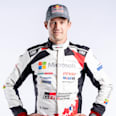Put yourself in Volkswagen’s shoes. What do you do when you've dominated theDakar Rally, the self-proclaimed “toughest race on earth”, three years in a row and you're getting a little bored? You turn your efforts toward the World Rally Championship is what.
While no one WRC event is quite as long or harsh as the infamous Dakar, the FIA World Rally Championship is a lot more varied, a lot faster and, some might argue, requires even more skill. With 13 events throughout a season, the cars encounter mud, snow, dirt, asphalt and gravel, regularly navigating their way around 200ft sheer drops, ludicrously fast forest stages and treacherous mountain passes.
So after pulling out of Dakar competition in 2011, Volkswagen directed all of its motorsport efforts towards the WRC, a title it hadn't competed for as a works team since 1987 – and the car that the team built for the job was the Polo R WRC.
The Polo is essentially based on Skoda’s Fabia Super 2000, with the Czech firm being part of the gargantuan Volkswagen group. But because of the lower spec of the Super 2000 cars compared to a World Rally Car, it took a little work to morph the Fabia into the full-on WRC-grade Polo that will head off into the stages of this year’s Rallye Monte-Carlo on January 16th.
Volkswagen started by replacing the 2-litre normally aspirated engine with a 1.6-litre turbo block with around 315bhp and 425nm of torque. The Polo also features a re-enforced tubular steel chassis which brings the weight down to around 1200kg, and an extreme aerodynamics package which pushes the car into the ground at high speeds.
The gearbox is a custom-made, sequential six-speed unit, sending the power through two differentials to all four wheels. Helping the drivers to cope with the terrain they’ll encounter in a WRC season is a set of McPherson struts, set up with 180mm of travel on tarmac stages and 275mm on anything loose, while the brakes on the car are 355mm ventilated discs.
The Polo was officially shown off to the world on December 2012, only a month before its official competition debut at the 2013 Rallye Monte-Carlo – where in Sebastien Ogier’s hands, the car finished an impressive second.
Ogier and his co-pilot Julien Ingrassia would sensationally go on to win the drivers’ title for Volkswagen on its first year back in the WRC, while Jari-Matti Latvala in the sister Polo also helped the team to bag the manufacturers’ title.
As Carlos Sainz, the two-time WRC champion who both won the Dakar for Volkswagen in 2010 and helped to develop the Polo, told Redbull.com recently: “The Polo R is the epitome of world rallying, the championship-winning car… the results speak for themselves.”
It looks like the offroad domination didn't stop when VW pulled out of the Dakar then – but what will the team do when it’s finished winning WRC titles?






